
There are many different theories for time travel. Steins;Gate uses the black hole theory mostly, by compressing the data of the brain (2.5 petabytes[1]), to a size sendable by the PhoneWave (name subject to change).
In the visual novel, Kurisu mentions that although there are many theories, 11 of them are widely accepted in the scientific world.
Neutron star theory[]
A neutron star is a type of stellar remnant that can result from the gravitational collapse of a massive star. These stars have a mass around 466,000 times the mass of the earth, thus exerting a very high gravitational force (1.962×1012 m/s2, earth's is 9.81 m/s2) although they have a diameter of 10-12 Km.[2] As for the Gravitational time dilation, time would pass 30% slower on the surface of such a star, meaning that if someone could travel to such a star and withstand this gravity, they would have a way to "travel" to the future. This theory only serves for time travel to the future, to the past wouldn’t be possible.
Black hole theory[]
Black holes are one of the most used resources in time-traveling novels, next to wormholes. The Kerr-black hole theory is the result of Roy Kerr's calculations for relativity. A Kerr-black hole is a singularity that possesses mass and angular momentum, but does not possess electrical charge. This hole spins around a central axis and has two event horizons, which contain a ring-formed singularity. Inside each of the two event horizons, time and space are reversed, so in a Kerr-black hole this swapping occurs twice. In theory, it's possible to escape the ring-formed singularity, although not by the same way you entered it, or simply avoiding it. Crossing the singularity would make you end up in a "negative space" (the definition is still unclear). Avoiding it would cause you to go back in time while you are crossing the first event horizon. Here's a Penrose diagram of two time travelers making their way through the black hole. The dark-blue one avoids the singularity and the light blue one crosses it:
Light Speed theory[]
It is unclear exactly what light speed theory refers to, but there are several connections with other theories and some basic principles that all of them have in common, all related in various ways to Albert Einstein’s relativity.
The first form of time travel that relates to light speed is when matter is accelerated to close to light speed, causing time to slow down for it due to time dilation from Einstein’s relativity. This can only be used to travel to the future, not to the past. One way to do this is by going near a neutron star, which is what the neutron star theory is about, although there are plenty of other ways to accelerate to near the speed of light. For instance, CERN’s Large Hadron Collider accelerates protons to 99.9999991% of the speed of light, slowing down time for them by a factor of 7,454, so, for instance, if 7.454 seconds elapse in the outside world, one of the protons inside the LHC at maximum speed only experiences 1 millisecond of time elapsing (0.001 seconds). While this first form of time travel is actually hard science and not science fiction, all it accomplishes is time travel to the future, not the past.
There are a number of theoretical ways to go back in time by traveling faster than light speed that exist as solutions to the equations of Einstein’s general relativity. The most obvious faster-than-light method is through tachyons, the hypothetical particles that move faster than light, covered under tachyon theory. Another faster-than-light method of travel that operates fairly similarly is the Alcubierre warp drive, covered under exotic matter theory. There is also a method involving light that goes faster than the normal light speed, covered under Cesium Laser theory. These 3 theories all involve going at speeds faster than light speed in order to travel back in time.
Under Einstein’s relativity, in a thought experiment Einstein came up with himself, the tachyonic antitelephone, Albert Einstein devised a method to send information back in time that is possible to do using any faster-than-light travel method; Einstein’s original theory used tachyons but it works just as well for the Alcubierre warp drive that uses exotic matter and for the laser light going faster than light speed in Cesium Laser theory.
However, Light Speed theory as used by Kurisu Makise was a separate theory from the other theories, but it is unclear what she meant by it, because there are so many different theories for time travel that involve light speed, it is impossible to tell which of them she was referring to with Light Speed theory.
Tachyon theory[]
The Tachyon or a Tachyon particle is a hypothetical particle that always moves faster than light, Most physicists believe that faster-than-light particles cannot exist because they are not consistent with the known laws of physics. The existence of such particles, called tachyons, has not been totally ruled out, but several experiments have tried, without luck to detect them. If they did exist, and they interacted with ordinary matter, it would give us the means to communicate with the past. Tachyons could literally be sent outwards, bounce off a tachyonic mirror, and return before they were sent. This in turn would give rise to a great many logical problems. For example, if you sent a message back in time that caused your grandfather to be killed before your father was conceived, then you would not be around to send the message that prevented your birth, so that you would be around to send the message, so that you wouldn't be around....etc.
Despite theoretical arguments against the existence of faster-than-light particles, experiments have been conducted to search for them. No compelling evidence for their existence has been found. In September 2011, it was reported that a tau neutrino had travelled faster than the speed of light in a major release by CERN; however, later updates from CERN on the OPERA project indicate that the faster-than-light readings were resultant from "a faulty element of the experiment's fibre optic timing system"
Wormhole theory[]
Wormhole theory, as Cosmic String theory, is explained by Makise Kurisu during her press conference:
-"In that case, why don't we go to our next example, wormhole theory? It may be a little more realistic than cosmic string theory. By the way Hououin-san, do you know what wormholes are?"
- -Kurisu Makise, chapter 1 of the VN
-"It's like a shortcut opened through space or something... right?"
- -Okabe Rintarou, chapter 1 of the VN

-"Yes, that's correct. There are two holes, tied together by a tunnel. Transit time through the tunnel is zero, no matter how far away the second hole is."
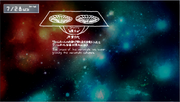
-"But there's a catch. The tunnel suffers from super gravity, and collapses as soon as it opens. And that's why we need something to negate the effect of gravity."
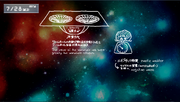
-" The so-called 'exotic matter'. It's a substance with negative mass, which repels gravity."
-"The wormhole tunnel is all squished and squashed like this fist of mine. In order to pass through, you need something inside of my hand to oppose the 'grasping force' so that I can not squish anymore."
-"If you stabilize a wormhole with exotic matter injection, teleportation becomes possible. For example, let's say there's a wormhole entrance here in Akihabara, and the exit is in LA. Now imagine the hole in LA goes all the way to the end of the universe at near-light speed. And once it reaches the end, it immediately pulls back to LA. According to the theory of relativity, time slows down for objects moving at the speed of light. Meaning the hole that returned to LA would be further in the past than the one in Akihabara. And with those co', Hououin-san can enter the wormhole and arrive at LA several years back. However, this cannot yet be called true 'time travel'. It is only 'pseudo-travel'. The so called Urashima[3] effect. The important part is to return to Akihabara from LA through the wormhole once more. Having done that, transit time becomes zero, and Hououin-san would return to Akihabara several years back. Time travel complete. The prerequisites for wormhole theory are simpler than the ones for cosmic string theory. First: the wormhole itself. They may exist somewhere in the universe, yet nobody has ever seen one. Second: The energy required to move a wormhole to the end of the universe and back near-light speed. Third: Exotic matter, which by the way, has not been confirmed to exist.'"
- -Kurisu Makise, chapter 1 of the VN
Exotic matter theory[]
Exotic matter, like described in the wormhole theory, has a negative mass. However, because exotic matter wasn’t confirmed to exist at the time Steins;Gate was made, the negative mass was also just a hypothetical property, similar to the imaginary mass of tachyon particles, which have still never been verified, and possibly giving exotic matter the ability to exceed the speed of light and be used to communicate with the past.
Professor Peter Engels and colleagues at Washington State University first produced exotic matter on April 10, 2017, by using lasers to cool rubidium atoms to just above absolute zero, turning the rubidium into a bizarre type of quantum fluid known as a Bose–Einstein condensate that has very unusual properties. They used a laser trap to reverse the spin of some of the rubidium atoms in the Bose–Einstein condensate, and then released the atoms from the trap, and then applied a pushing force on the atoms, and rather than going in the direction they were pushed, the atoms went in the opposite direction.
According to Isaac Newton’s equation F = ma from Newton’s Second Law of Motion, where force equals mass times acceleration, if you push on something with positive mass, it goes in the direction it is pushed in, with the force and acceleration having the same direction. But if something has negative mass, the force and acceleration end up with opposite signs, so if a force is applied in one direction, the negative mass object is accelerated in the opposite direction. This applies both to gravity and to all other forces as well. This is why, when the team at Washington State University observed that the rubidium in their Bose–Einstein condensate went in the opposite direction from the direction it was pushed in, this confirmed that it was indeed exotic matter.
Along with the way exotic matter can be used to stabilize a wormhole in order to make it traversible for time travel via wormholes, there are other methods of time travel using exotic matter. The most popularly discussed method is the Alcubierre warp drive, which requires exotic matter to create an area of space with negative mass, and achieves faster-than-light travel by warping the space-time continuum, contracting space in front of a spacecraft using the warp drive and expanding space behind the spacecraft.
Once the Alcubierre warp drive using exotic matter is achieved, faster-than-light travel can be used to go back in time, using the same mechanism as tachyons, as originally explained in Albert Einstein’s thought experiment of the tachyonic antitelephone that would use tachyons (subatomic particles that move faster than light speed) to send information back in time. The difference is, you could actually build a spacecraft and it would produce an Alcubierre warp drive around it using exotic matter, in order to achieve physical time travel of ordinary matter back in time, including people inside a spacecraft and whatever else they want to bring along. So while tachyons would only be able to send data back in time, similar to D-Mail or the Time Leap Machine, the Alcubierre warp drive could be used for physical time travel, similar to the FG204.
Practically speaking, however, an Alcubierre warp drive is very hard to build, even if you have exotic matter, and the exotic matter made from a Bose–Einstein condensate is pretty hard to handle. While exotic matter was experimentally proven to exist in 2017 and can be made from the naturally occurring element rubidium, building the Alcubierre warp drive necessary to use it for faster-than-light travel and going back in time is still in the realm of science fiction, not because of it violating any laws of physics, but just because it is so impractical.
Cosmic String theory[]
The cosmic string theory for time travel was developed by the physicist J. Richard Gott and is explained in the 2002 book How to Build a Time Machine by Paul Davies. In the visual novel, Kurisu Makise explains the cosmic string theory at her conference:
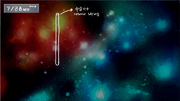
-"A Cosmic String is a string-shaped crack which has an extreme mass. You can think of the crack as something the width of an elementary particle, and at least the length of a galaxy."
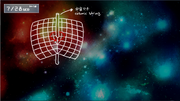
-"It has an immense mass, giving it the property of space-time distortion. If you were to travel through that distortion you could make a full rotation around the string in less than 360 degrees."
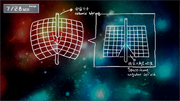
-"In short, you can do something resembling a warp. This is called Space-time angular deficit. When you pass through an area of angular deficit, transit time becomes zero."
-"Applying this, once the cosmic string moves approaching light speed, according to the theory of relativity, time will flow slower for the cosmic string in relation to its surroundings. Therefore, passing through the area of angular deficit would cause the zero transit time to become negative. In other words, it will be the 'past' after transit. So, if you use two cosmic strings, you can do a space deficit jump. If you revolve back to your original location, you can return to the same time you started revolving. And that, roughly speaking, is time travel by means of cosmic string theory."
-"By the way, so nobody misunderstands, cosmic string theory is different from superstring theory. With that out of the way, you need three things in order to travel to the past with cosmic string theory. First: Cosmic Strings. Two of them are necessary. Ah, by the way, they are hypothesized to exist only where the universe was first formed, so they might be a little hard to find". Second: Even if you do find the strings, you need the energy to make them move at near-light speed. Just how much energy do you think you'd need to accelerate something as long as the milky way to near-light speed? I'm pretty sure it's a little bit more than 1,21 jigowatts''[4]. Third: a space ship able to go all the way to the cosmic strings. The time traveler must be on board. What do you think Hououin-san? Care to take on the challenge of cosmic string theory time travel?"
Quantum Gravity theory[]
To try to understand how general relativity can be united with quantum mechanics, physicists have been attempting to develop a theory of Quantum Gravity. There are several models of Quantum Gravity, but not all of them allow us to time travel. In order to achieve this, we must use a model that includes a closed timelike curve (such as the Causal Set theory), which is defined as the following concept:
A Closed Timelike Curve (sometimes abbreviated CTC) is a theoretical solution to the general field equations of the theory of General Relativity. In a Closed Timelike Curve, the worldline of an object through spacetime follows a curious path where it eventually returns to the exact same coordinates in space and time that it was at previously. In other words, a closed timelike curve is the mathematical result of physics equations that allows for time travel.
Although it isn’t a popularly accepted theory between physicists, a model of the Quantum Gravity theory called “Loop Quantum Gravity” might allow time travel. In Loop Quantum Gravity, gravity is made up of particles called quanta. But these particles aren't like photons or quarks. Quanta are the basis of space and time itself. What we perceive as space is actually a sequence of quanta, and what we see as time is how quanta evolve.
Closed timelike curves would need a section of spacetime where time loops back on itself. If spacetime is globally hyperbolic, there are no locations where this might happen. Therefore, it looks like Loop Quantum Gravity does not allow time travel, but some physicists think that it may be possible to achieve time travel using larger scales in which the causality theory doesn’t apply.
Cesium Laser theory[]
The work of Dr. Lijun Wang at the NEC research institute in Princeton seems to have given us a glimpse of multi-dimensional reality. When Wang recently transmitted a pulse of light towards a chamber filled with specially treated cesium gas, and recorded its travel through the chamber at an accelerated speed of up to 300 times the speed of light, he proved the possibility of time travel.
Before the pulse fully entered the chamber, Wang reported that it appeared at the same instant at a point 60 feet across the laboratory. In effect, it existed in two places at the same time. Thus Wang not only proved that objects can move at speeds exceeding the earlier prescribed limit of 186,000 miles per second, but he proved Einstein's theory that time slows when objects travel at a speed approaching (and exceeding) the speed of light. The implications of this are mind-boggling. Wang's work hints that time travel is quite possible.
http://perdurabo10.tripod.com/themindofjamesdonahue/id73.html
Scientists at NEC Corporation's (NEC) basic research unit in the US claim to have proven that light can travel faster than its acknowledged speed in vacuum in a successful experiment in superluminal light propagation.
Despite exceeding the vacuum speed of light, the experiment is not at odds with Einstein's theory of relativity and is explainable by existing physical theory. The research work, which may result in significantly faster information transfer speeds across networks and in computers, was published in Nature by NEC research scientists Dr. Lijun Wang, Dr. Alexander Kuzmich and Dr. Arthur Dogariu.
In the experiment, NEC scientists measured the time taken by a pulse of light to pass through a 6cm-long specially prepared chamber containing cesium gas. The 3-microsecond long pulse of light would normally take only 0.2 nanoseconds to pass through the chamber in a vacuum. But when passed through the specially prepared chamber, light emerged 62 nanoseconds earlier than it would have had it passed through the chamber in a vacuum. This unusual phenomenon is the result of "anomalous dispersion", an effect not seen in nature in transparent materials and is created by the non-natural thermal state of the cesium gas used in the chamber.
A pulse of light consists of many components, each at a different wavelength as can be seen when sunlight passes through a prism in "normal dispersion" and is broken down into its constituent colors. The effect of anomalous dispersion on the wavelengths of the components of light, however, is to modify them. Anomalous dispersion causes components with a shorter wavelength in a vacuum to have a longer wavelength in the chamber and conversely, components with a longer wavelength in a vacuum have a shorter wavelength in the chamber. Unlike with normal dispersion, anomalous dispersion has the extraordinary effect of enabling a light pulse to appear again at a distant point along its direction of propagation and produce the exact shape of the light pulse that entered the chamber. A light pulse can thus traverse the distance between two points faster than its vacuum speed.
"Our experiment shows that the generally held misconception that nothing can move faster than the speed of light, is wrong. Einstein's Theory of Relativity still stands, however, because it is still correct to say that information cannot be transmitted faster than the vacuum speed of light," said Dr. Lijun Wang. "We will continue to study the nature of light and hopefully it will provide us with a better insight about the natural world and further stimulate new thinking towards peaceful applications that will benefit all humanity."
Source (Archive Article): https://optics.org/article/8562
Scientists have seen a pulse of light emerge from a cloud of gas before it even entered. This astonishing and baffling observation was made by researchers from the NEC Research Institute in Princeton, US. They conducted an experiment that involved lasers, a chamber containing cold caesium atoms and a super-fast stopwatch. The end result was a beam of light that moved at 300 times the theoretical limit for the speed of light. It was Einstein who said nothing physical could break this barrier because, among other things, to do so would also mean travelling back in time.
...
But the NEC scientists believe their work does not violate Einstein's theory. Writing in the journal Nature, Dr Lijun Wang and colleagues say their light beam raced through the atom trap so quickly that the leading edge of the pulse's peak actually exited before it had entered. If this sounds confusing, then do not worry. Many physicists are uncomfortable with it too despite their explanations that it is a natural consequence of the wave nature of light.
Although the work of Dr Wang's team is remarkable, it is not the first time that this sort of "trick" has been performed - but it is certainly the most dramatic demonstration. Earlier this year, a team of physicists made a microwave beam travel 7% faster than light speed. Last year, they announced that they had even slowed light down to almost a crawl.
BBC News, Article "Beam smashes light barrier"
There is also The Guardian article, misleading entitled as "Light goes backwards in time"
The scientific paper about superliminal cesium laser pulse named "Gain-assisted superluminal light propagation" with authors L. J. Wang, A. Kuzmich & A. Dogariu and published in Nature
The similar earlier experiment (2000) with microwaves was made by Italian scientists D. Mugnai, A. Ranfagni, and R. Ruggeri and published in Physical Review Letters under the title "Observation of Superluminal Behaviors in Wave Propagation"
Even earlier (1999) G. Nimtz in his paper "Evanescent modes are not necessarily Einstein causal" (II. Physikalisches Institut, Universität Köln, Zülpicherstrasse 77, 50937 Köln, Germany) stated that his team encoded Mozart’s 40th Symphony on a microwave and reported that this ‘signal’ was transmitted at 4.7c (backward in time), though overwhelming majority of scientists believe that Nimtz misinterpreted his results and signal was transmitted only at c (and not backward in time).
Elementary particle ring and laser theory[]
Elementary particle ring and laser theory is a time travel theory developed by Professor Ronald Mallett of the University of Connecticut in Storrs, Connecticut. It involves using a ring laser to generate closed timelike curves or CTCs for short. It is based on an older time travel theory called the Tipler cylinder except modified to be more practical, as Tipler cylinders would have to be infinitely long so Ronald Mallett came up with a better way to generate CTCs using only a ring laser.
Basically, the circulating light beams of a ring laser can theoretically twist spacetime and allow the dimension of time to be traversible just like the dimension of space is normally traversible. Then, one could theoretically walk through time in any direction, as one can do in space. It works by producing gamma ray or magnetic fields to warp time into CTCs. Theoretically, this could be used for physical time travel for human beings.
Professor Ronald Mallett has been working on making a time machine based on this theory for several decades, since the 1970s, and has made improvements to his theory over the years to try to bring it to fruition. He only went public with his theory in 2002 and since he is a theoretical physicist and not an experimental physicist, he works with an experimental physicist at the University of Connecticut on trying to build a time machine. He is one of the few mainstream scientists who has done serious work on time travel, and has actually devoted his entire career to trying to build a time machine based on his theory. He first became interested in time travel when, at age 10, his 33-year-old father died of a heart attack, and then a year later, when he was 11, Ronald Mallett read a comic book version of H.G. Wells’ The Time Machine. He immediately resolved to build a time machine and devoted the rest of his life to this task.
Ronald Mallett got a Ph.D in physics from Penn State in 1973 and became an assistant professor of physics at the University of Connecticut in 1975, being promoted to full professor in 1987, and has received numerous prestigious awards for his work in physics, both theoretical and experimental. Currently, he is a professor emeritus and is retired from teaching, giving him more free time for his time travel research. He kept his time travel theory completely secret from the rest of the world until finally going public with it in 2002, for fear of being rejected from the scientific community. However, when he presented his time travel theory to an international group of theoretical physicists in 2002, he was warmly received and his ideas were taken very seriously, and he was able to start working with an experimental physicist at the University of Connecticut on trying to build a time machine.
The physicists Ken Olum and Allen Everett wrote a 2005 paper attempting to debunk Ronald Mallett’s time travel theory involving ring lasers. One of their criticisms is that the spacetime in Mallett’s theory contains a type of singularity known as a “line source” which is there even when the ring laser time machine is turned off, and that singularities wouldn’t normally just randomly appear in random parts of spacetime here on Earth for no reason.
Another criticism is that the energy required to twist spacetime in the way Mallett talks about would require the ring laser to be many times larger than the observable universe in circumference. Their third criticism is that according to a theorem from a 1992 paper Stephen Hawking wrote on the Chronology Protection Conjecture, it is impossible to create CTCs in a finite amount of space without using exotic matter, although since the line source is infinite in length, this part does not apply if the line source actually exists.
Thus, if we accept the existence of the line source, the only remaining criticism is the one about the amount of energy required. Ronald Mallett devised a workaround to lower the amount of energy required, by having the laser light go through a medium that slows down its speed to a small fraction of the speed of light. The physicist J. Richard Gott (himself the creator of the Cosmic String theory of time travel, and someone who believes time machines are possible) criticized this workaround and said that it would not accomplish anything to slow down the light, so Ronald Mallett abandoned the idea of slowing down the light.
Ronald Malett came up with an alternative workaround to decrease the amount of energy required, namely, instead of sending human beings or large objects back in time, only sending subatomic particles or information back in time, as this would require much less energy for the ring laser system and make it much more feasible (the same way D-Mail is much more feasible to set up than a physical time machine in Steins;Gate).
Ronald Mallett doesn’t think that his time machine would cause paradoxes, but instead that it would shift reality into a parallel universe when one changes the past based on the many-worlds interpretation of quantum physics, similar to the Attractor Field theory and world lines in Steins;Gate. Here is a video interview from WPSU public broadcasting of Ronald Mallett where he talks about his time travel research:
Dirac antiparticle theory[]
Dirac antiparticle theory, more commonly known as Dirac hole theory, was the original theory to explain the existence of antimatter from 1929, postulated by Paul Dirac. It is derived from the Dirac equation formulated in 1928, a relativistic version of the Schrödinger equation that improved on the Schrödinger equation by making it compatible with Einstein’s relativity (which was rather important, since the purpose of the Schrödinger equation was to explain the behavior of electrons, electrons typically move near the speed of light, and any equation describing things moving near light speed that does not incorporate relativity produces erroneous results). The Dirac equation is still used today, and many other equations and theories have been based on it.
Negative energy solutions to the Dirac equation were discovered in 1929 by Paul Dirac and others. This was a problem since they had never been observed in reality, and they would allow electrons to emit photons repeatedly to go into negative energy states an infinite number of times, something that does not happen, is not how atoms behave, and would completely ruin the theory of conservation of energy. Paul Dirac solved this problem with Dirac hole theory, which he proposed in 1930, which says that there is an infinite “sea” of negative energy connected to every point in our universe called the Dirac Sea, and when there are “holes” in the Dirac Sea, they appear as antimatter in our world. Electrons cannot fall into negative energy states because those are already filled by negative-energy electrons in the Dirac Sea. In 1932, antimatter was experimentally discovered in 1932 by Carl David Anderson, giving experimental confirmation of Dirac hole theory.
Another theory, quantum field theory, was also gradually being developed over the years, and became a preferred explanation to antimatter, compared to Dirac hole theory, which it is mathematically equivalent to (using the exact same Dirac equation), and Paul Dirac also made important contributions to quantum field theory. However, the Dirac hole theory, also known as Dirac antiparticle theory, and its corresponding Dirac Sea, have many important theoretical predictions they make and things they can explain. For example, in ChäoS;HEAd, Dirac hole theory and the Dirac Sea are an important part of the explanation of real-booting, DI-Swords, gigalomaniacs, and the technology of Project Noah. This video explains antimatter and the Dirac hole theory:
Dirac hole theory, or as it is called in Steins;Gate, Dirac antiparticle theory, can also be used as an explanation for time travel. It is actually an extremely simple explanation. Antimatter is exactly the same as matter, mathematically speaking, except if you mathematically negate time the values for time, and related quantities that use odd powers of time such as velocity, momentum, and angular momentum (quantities that use even powers of time like acceleration, force, work, and energy are unchanged since if you square a negative number you get a positive number). This explains things like how electrons have a spin of positive ½ but positrons (the antimatter equivalent to electrons) have a spin of negative ½, as spin is a measure of angular momentum which has an odd power of time, so if time is negated, spin is negated. Because of the way electric charge is derived from spin, electrons have a negative charge but positrons have a positive charge, which is what gives them the name “positrons”, short for “positively charged electrons”.
But what does a negative value of time actually mean? Quite simply, what it means is that time moves in the opposite direction for antimatter compared to mater. While matter moves from the past through the present to the future, antimatter moves from the future through the present to the past. The directionality of the arrow of time for the universe, how it goes from past to future, is closely tied to the fact that the universe has far more matter than antimatter, and for matter, time goes from the past to the future. It would be the opposite if the universe was mostly made of antimatter instead of matter, and the past and future would be reversed. This would also reverse the direction of causality, too, with events in the future being the causes, and their effects taking place in the past, so in everyday life, in a universe made of antimatter instead of matter, nobody would notice any difference at all.
Anyway, the important part is, antimatter travels backwards in time rather than forwards in time like matter, and actually, this is to be expected, since the laws of physics have many symmetries, and for time to only go in one direction rather than in both directions would break time symmetry, which is bad. This might seem to allow information to be sent to the past using antimatter. In fact, one can describe the processes of pair production and annihilation, rather than as an electron and positron both coming into existence from a gamma ray or spontaneously in the vacuum of space, then existing a short time and then annihilating back into another gamma ray or into the vacuum again, as a single electron/positron particle that goes in a type of closed time loop, going forward in time from the moment of pair production to annihilation as an electron and going backwards in time from the moment of annihilation to the moment of pair production as a positron, so really, the electron and the positron observed in pair production are actually the same particle, rather than 2 separate particles, just observed in different parts of a time loop that particle is stuck in which makes it not exist before or after given moments in time that are typically quite close to each other.
There are some ways that this theory is impractical, though. First of all, there is a theory stating that it is impossible to send information back in time. In practice, this would mean, among matter particles, it is impossible for matter particles to send or receive information that comes from the future to the past, while among antimatter particles, it is impossible for antimatter particles to send or receive information that comes from the past to the future. Both matter and antimatter only experience time and causality in one direction in time, and since matter and antimatter are opposites and cannot be converted from one to the other, only created or annihilated in pairs, it is impossible to use this method to send information back in time from a person who is made of matter in the future to a person who is made of matter in the past.
Secondly, antimatter is very hard to produce and it is impractical to produce any significant quantity of it. The largest amounts of antimatter are currently produced at CERN in its Antimatter Factory in France, just outside Geneva, Switzerland, which began operations in 2000, although between 1985 and 2011, the largest amounts of antimatter were produced at Fermilab, at its Antiproton Source in Batavia, Illinois, which was shut down in 2011. This video provides a brief overview of antimatter production at CERN:
Third, antimatter immediately annihilates with matter upon impact, making it very hard to handle. This annihilation process is thought to prevent information from going back in time, but even if it were possible to use antimatter to send information back in time, it would be extremely difficult. Antimatter particles typically only survive for a very tiny fraction of a second, so even if one could be used to send information back in time, it would be extremely hard to send it further back in time than a very tiny fraction of a second.
To send information back in time a longer amount of time than a tiny fraction of a second, even if this worked, the antimatter would have to be isolated from all the matter around it with a vacuum in between, holding it in place using some sort of mechanism like lasers or electromagnetic fields. Both CERN and Fermilab have this technology and use it to store antimatter, so this part of the theory works out. Unfortunately, storing antimatter in such a way prevents it from interacting with matter, which also prevents anyone from getting information from the antimatter, so this presents a serious problem for anyone trying to use antimatter to send information back in time.
And in order to get information from antimatter, it is necessary to get the information in an earlier point in time, such as soon after it is created, rather than in a later point in time, like when it is annihilated, and then keep the antimatter around for some amount of time, stably, in order to allow it to get information from the future, a technology nobody has developed yet, not even at CERN or Fermilab. So even if antimatter worked for sending information back in time, it would be very impractical.
However, one way to do this would be to bounce photons off of antimatter that is stably stored using technology that CERN and Fermilab both already have for storing antimatter. These photons could get information from the antimatter, in the same way that if you bounce photons of light off of matter, and then the photons reach your eye, you can see it, sending information about the matter to your brain through the optic nerve. These would probably have to be low-energy photons such as radio waves or microwaves in order to avoid disrupting the antimatter and knocking it out of place, where it is being held in place by lasers or electromagnetic fields.
But even if this technology is developed, to get information out of antimatter through photons, there would have to be some method invented for storing bits of data in antimatter, which would have to be done in the future, and then retrieving that same data in the past. Antimatter is typically just individual subatomic particles rather than atoms or molecules. This method would first be developed using matter, storing bits of data in subatomic particles in the past and retrieving that same data in the future, since that is easier than using antimatter, and after that technique is perfected using matter, it could be done with antimatter except with time reversed. This would allow for sending information back in time.
Nobody even knows how to do this using matter yet, so doing it with antimatter, with time reversed, is beyond current technology. And even if it worked with matter, it is completely unknown whether or not it would work with time reversed with antimatter; doing such an experiment would allow scientists to determine if it is possible to send information back in time experimentally. So far, there is no experimental data on this, only theories, namely a theory which says this is impossible which, while unproven, is the scientific consensus, and other people who question this theory, and could possibly disprove that theory by experimentally demonstrating that they can send bits of data back in time using antimatter.
Notes[]
- ↑ According to Kurisu Makise in the anime
- ↑ wikipedia, neutron star
- ↑ In the legend of Urashima Taro, he's given a box that makes him age upon opening it
- ↑ Joke about the energy it taken to travel back in time on the DeLorean, the time machine from Back to the Future'








